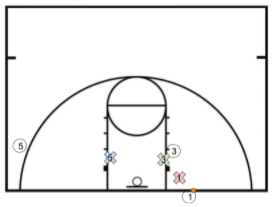Contents > 2. Defense > 2.1. Player-to-Player, 1/4 Court Defense > 2.1.4. Combined Defensive Situations > 2.1.4.2. Special Situations >
2.1.4.2.1. Out-of-Bounds Defense
(1) Q: What is the goal of the defense during an offensive throw-in from out-of-bounds?
A: The overall goal of the defense will stay the same - force low percentage shots (contested and far from the basket). When the offense is throwing the ball in from out-of-bounds, it is almost the same as when an inbounds ball-handler picks up their dribble and can only pass (with 5 seconds to pass). The on-ball defender will try to make this pass as difficult as possible (and perhaps will get a deflection, steal, or force a bad pass which leads to a defensive teammate getting a steal). However, the slight advantage the offense now has while throwing the ball in is the boundary line prevents the defense from getting extremely close to them, so the offense has more space, and less pressure from the defense, to see the court and pass the ball.
(2) Q: How do we defend against throw-ins to achieve this goal?
A: There are two types of throw-ins: from the sideline and the baseline. Each will have their own slightly different defensive strategies.
(3) Q: How do we defend sideline throw-ins?
A: This will depend on where the ball is being thrown in from: above or below the approximate ¼-court imaginary line (one step above the three-point line at the top of the key).
(4) Q: How do we defend sideline throw-ins if it is above the ¼-court line?
A: When we are in our normal ¼-court, 3-point line defense, we will set up in our normal defense and wait for the offense to arrive (since we do not need to defend one step past the 3-point line). The “on-ball” defender does not need to defend the inbounder close to the throw-in area (doing so runs the risk of the on-ball defender not being able to play proper deny and help defense once the ball is thrown in).
(5) Q: How do we defend sideline throw-ins if it is below the ¼-court line?
A: In this situation, we will play our normal ¼-court defense, however it is best if the on-ball player faces the inbounder very close to the sideline, staying between the inbounder and the basket. Since the inbounder can only pass, the on-ball defender should have their hands/arms wide to make the inbounds pass difficult, mirroring the ball. Once the ball is thrown in, the on-ball defender must quickly transition into deny or help defensive positioning.
(6) Q: How do we defend baseline throw-ins?
A: Baseline throw-ins are usually more dangerous than sideline, since the ball is starting much closer to the basket. Since our goal is to force contested shots far from the basket, it is best if we force a long inbounds pass to the top of the key, making the offense restart their offense farther away from the basket. To prevent passes near the basket, those in deny defense must play more aggressive deny, and those in help defense can help farther into the key (unless they are defending a very good three-pointer shooter). For screens that occur close to the throw-in spot, it may be best to switch no matter what (even with different sized defenders) to prevent the quick pass near the hoop. If a long pass to the top of the key is made, then the defense will have time to switch back to their regular defensive assignments. The on-ball defensive player must make the pass to the basket extremely difficult (never turn your back to the inbounder - they can throw the ball off your back).
SKILLS DRILLS
Skills Drill #1: Sideline Out-of-Bounds Defense (Live)
Offense (3-5 players) will throw the ball inbounds from either sideline in the ¼-court. Defense will play proper out-of-bounds defense. Offense will have 5 seconds to score once the ball is thrown in.
Skills Drill #2: Baseline Out-of-Bounds Defense (Live)
Same as Skills Drill #1, except the ball will be thrown in anywhere from the baseline.








